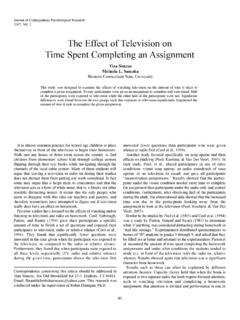Transcription of THE AMERICAN IDOL EFFECT: ARE STUDENTS GOOD …
1 EMPIRICAL STUDIES OF THE ARTS, Vol. 28(1) 3-17, 2010 THE AMERICAN idol EFFECT: ARE STUDENTS GOOD judges OF THEIRCREATIVITY ACROSS DOMAINS?JAMES C. KAUFMANMICHELLE L. EVANSC alifornia State University, San BernardinoJOHN BAERR ider UniversityABSTRACTS tudents are often asked to judge their own creativity . There is some evidencethat such judgments correlate modestly with other self-report data andsome divergent thinking test measures. Only limited work, however, has beendone comparing self-reported creativity with actual creative levels of self-reported creativity might vary across domains which would allow greater likelihood of accuracy of such reports weexamined self-reports of creativity in four domains and compared these withexpert ratings of subjects work in those domains (as judged using theConsensual Assessment Technique).
2 Subjects were 78 fourth-grade STUDENTS did not predict uniform levels of creativity for themselvesacross domains (all self-assessments correlated across domains less ). However, these predictions did not match expert ratings of thestudents creative products in each domain . These results challenge thevalidity of self-assessments of creativity among STUDENTS of this age, evenwhen the STUDENTS are given the opportunity to give themselves differentcreativity ratings in different 2010, Baywood Publishing Co.
3 , : people good judges of their own creativity ? Certainly, those who regularlywatch AMERICAN idol or similar shows have seen much anecdotal evidence that theanswer may be no. Many contestants have demonstrated a sincere passion forsinging and a belief in their own abilities yet with strikingly little talent to gowith it. Perhaps the most salient example is William Hung, a Berkeley engineeringstudent, who performed an enthusiastic yet poorly received song on the popularshow, prompting one judge to remark, You can t sing, you can t dance, so whatdo you want me to say?
4 (Bulwa, 2004). His singing actually became popularbecause Hung s passion and belief in his own abilities were such a mismatchwith his actual talent; people often attended his performances for humor ratherthan musical , it is not only AMERICAN idol that gives people a chance to demon-strate the disconnect between their opinions about their beliefs and their actualtalent. The vanity press publishers who advertise regularly in theNew YorkReview of Booksoffer titles and descriptions of books that have beenself-published that may not immediately strike a reader as being quality creativework.
5 One such press, Vantage Press, sells its services by asking questionsthat appeal to people s lack of knowledge about their own creative capabilities,such as, Is your subject so timely that you can t afford to wait two years ortwo months for publisher s reaction to your manuscript? They also tell theirpotential customers that:If you re considering subsidy publishing, you re in elite company. Literaryluminaries who gained renown after publishing their own work at their ownexpense comprise a veritable Who s Who novelists, poets, playwrights.
6 For example, Thomas Gray, Elizabeth Barrett Browning,Alexander Pope, Percy Bysshe Shelley, Alfred Lord .. (VantagePress, 2008)Who are these people who audition for AMERICAN idol despite a lack of abilityand send unpublishable manuscripts to vanity presses? Such people would seemto be low in metacognitive skill, the ability to monitor one s own learning, performself-evaluation, and then make plans accordingly (Everson & Tobias, 1998;Flavell, 1979). Someone who was high in metacognitive abilities would knowhis or her limitations, be able to seek help, and estimate success with reasonablyhigh accuracy.
7 There are some theoretical links between metacognition andcreativity ( , Naglieri & Kaufman, 2001). Several theorists, such as Boyce,Van Tassel-Baska, Burruss, Sher, and Johnson (1997), Feldhusen and Goh(1995), Jausovec (1994), and Davidson and Sternberg (1998) have argued thatmetacognition is connected to creative problem solving and that someone whois high in metacognitive ability should be a more creative problem it has been argued that high metacognitive ability should be associated withbetter and more creative performance, and the flipside of this connection thatthose lacking metacognitive skill will generally exhibit little creativity has also4 / KAUFMAN, EVANS AND BAER been proposed by Kruger and Dunning (1999; see also Dunning, 2005; Dunning,Johnson, Ehrlinger, & Kruger, 2003.)
8 Kruger, 1999). People who do poorly inintellectual (and social) realms may suffer from a double whammy they arenot only underperformers, but they also have lower metacognitive abilities andtherefore are unable to recognize their poor performance. Indeed, this line ofresearch has led at least one blogger to coin the term the AMERICAN idol effect (Koehler, 2006a, 2006b).This question has only recently been addressed in the creativity of the work on self-assessment has been led by Adrian Furnham and hiscolleagues. Most of his studies have looked at self-assessed intelligence, find-ing medium-level correlations (.
9 30 to .50) between self-ratings and test scores( , Chamorro-Premuzic, Furnham, & Moutafi, 2004; Furnham & Chamorro-Premuzic, 2004; Paulhus, Lysy, & Yik, 1998). He has conducted some studieson self-assessed creativity (Furnham, 1999; Furnham, Zhang, & Chamorro-Premuzic, 2006), finding that self-assessed creativity was significantly related tocreativity as measured by the Barron Welsh Art Scale. In other studies, Park,Lee, and Hahn (2002) found self-reported creativity to significantly correlate withall scores on the Torrance Tests of Creative Thinking (TTCT) except for fluency,and Phillips (1973) found that self-assessments differed between high-scorerson the TTCT and that focus on non-psychometric measures are less clear.
10 Self-report measures tend to correlate highly with each other ( , Fleenor & Taylor,1994; Goldsmith & Matherly, 1988; Kaufman & Baer, 2004), although self-report measures do not appear to correlate highly with self-reported creativeactivities (Eisenman & Grove, 1972). Lee, Day, Meara, and Maxwell (2002)used three measures of creativity (verbal, pictorial, and self-report) and foundlittle relationship among the three measures. Priest (2006) found that STUDENTS self-assessment of the creativity of their musical compositions was not predictiveof expert ratings of these same do self-assessments stack up against creative performance in multipledomains?

